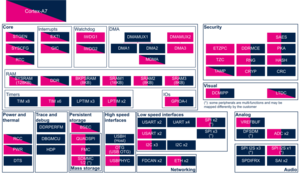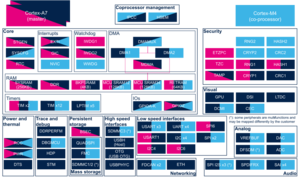Registered User m (Reverted edits by Registered User (-) to last revision by Registered User) Tag: Rollback |
Registered User |
||
| (16 intermediate revisions by 4 users not shown) | |||
| Line 1: | Line 1: | ||
<noinclude> | <noinclude>{{ApplicableFor | ||
{{ | |MPUs list=STM32MP13x, STM32MP15x | ||
|MPUs checklist=STM32MP13x,STM32MP15x | |||
}}</noinclude> | |||
}} | |||
</noinclude> | |||
==Peripheral overview== | ==Peripheral overview== | ||
The '''BKPSRAM''' internal memory | The '''BKPSRAM''' internal memory is located in the VSW power domain, allowing it to be supplied during Standby [[Power overview|low power mode]], or to be switched off.<br> | ||
* {{MicroprocessorDevice | device=13}} BKPSRAM is 8 Kbytes wide.<br> | |||
* {{MicroprocessorDevice | device=15}} BKPSRAM is 4 Kbytes wide. | |||
===Features=== | ===Features=== | ||
Refer to [[STM32MP15 resources#Reference manuals|STM32MP15 reference manuals]] for the complete feature list, and to the software components introduced below, to see which features are currently implemented.<br> | Refer to [[STM32MP13 resources#Reference manuals|STM32MP13 reference manuals]] or [[STM32MP15 resources#Reference manuals|STM32MP15 reference manuals]] for the complete feature list, and to the software components introduced below, to see which features are currently implemented.<br> | ||
===Security support=== | ===Security support=== | ||
| Line 22: | Line 15: | ||
==Peripheral usage and associated software== | ==Peripheral usage and associated software== | ||
===Boot time=== | ===Boot time=== | ||
The BKPSRAM internal memory is not used during a [[Boot | The BKPSRAM internal memory is not used during a [[Boot chain overview|cold boot]] or a wake up from Standby with [[DDRCTRL and DDRPHYC internal peripherals|DDR]] OFF. | ||
The BKPSRAM internal memory is used by the runtime secure monitor (from the [[Boot | The BKPSRAM internal memory is used by the runtime secure monitor (from the [[Boot chain overview|FSBL]] or the [[OP-TEE overview|OP-TEE secure OS]]) during wake-up from Standby [[Power overview|low power mode]] with the [[DDRCTRL and DDRPHYC internal peripherals|DDR]] in Self-Refresh mode. In that case, the BKPSRAM internal memory contains the secure context that has to be restored before jumping back to Linux execution, in [[DDRCTRL and DDRPHYC internal peripherals|DDR]]. | ||
===Runtime=== | ===Runtime=== | ||
====Overview==== | ====Overview==== | ||
The BKPSRAM peripheral can be allocated to: | The BKPSRAM peripheral can be allocated to either: | ||
* the Arm<sup>®</sup> Cortex<sup>®</sup>-A7 secure to be used | * the Arm<sup>®</sup> Cortex<sup>®</sup>-A7 secure to be used by the runtime secure monitor (from the [[Boot chain overview|FSBL]] or the [[OP-TEE overview|OP-TEE secure OS]]) to save/restore the secure context before entering/after exiting Standby [[Power overview|low power mode]] with DDR in Self-Refresh mode. Standby low power mode is reached thanks to PSCI <ref>http://infocenter.arm.com/help/topic/com.arm.doc.den0022d/Power_State_Coordination_Interface_PDD_v1_1_DEN0022D.pdf</ref> secure services (from the [[Boot chain overview|FSBL]] or [[OP-TEE overview|OP-TEE]] secure monitor). This is the default assignment. | ||
or | or | ||
* the Cortex-A7 non-secure to be used under Linux<sup>®</sup> as [[Reserved memory|reserved memory]], for instance. | * the Cortex-A7 non-secure to be used under Linux<sup>®</sup> as [[Reserved memory|reserved memory]], for instance. | ||
{{Warning | Default OpenSTLinux delivery prevents to define BKPSRAM as non-secure. This requires to modify TF-A source code with one of the following strategies: | |||
* set BKPSRAM as non-secure and degrade low power modes support, removing Standby mode | |||
or | |||
* manage on-the-fly secure/non-secure switch of the BKPSRAM in the secure monitor for sequential usage for Standby management and Linux kernel reserved memory}} | |||
====Software frameworks==== | ====Software frameworks==== | ||
{{: | ===== On {{MicroprocessorDevice | device=13}} ===== | ||
{{:STM32MP13_internal_peripherals_software_table_template}} | |||
| Core/RAM | |||
| [[BKPSRAM internal memory|BKPSRAM]] | |||
| [[Boot chain overview|FSBL]] or [[OP-TEE overview|OP-TEE]] secure monitor | |||
| [[Reserved memory|Linux reserved memory]] | |||
|- | |||
|} | |||
===== On {{MicroprocessorDevice | device=15}} ===== | |||
{{:STM32MP15_internal_peripherals_software_table_template}} | |||
| Core/RAM | | Core/RAM | ||
| [[BKPSRAM internal memory|BKPSRAM]] | | [[BKPSRAM internal memory|BKPSRAM]] | ||
| [[ | | [[Boot chain overview|FSBL]] or [[OP-TEE overview|OP-TEE]] secure monitor | ||
| [[Reserved memory|Linux reserved memory]] | | [[Reserved memory|Linux reserved memory]] | ||
| | | | ||
| Line 48: | Line 56: | ||
====Peripheral assignment==== | ====Peripheral assignment==== | ||
{{: | ===== On {{MicroprocessorDevice | device=13}} ===== | ||
< | {{:STM32MP13_internal_peripherals_assignment_table_template}} | ||
<section begin=stm32mp13 /> | |||
| rowspan="1" | Core/RAM | |||
| rowspan="1" | [[BKPSRAM internal memory|BKPSRAM]] | |||
| BKPSRAM | |||
| <span title="assignable peripheral" style="font-size:21px">☐</span> | |||
| <span title="assignable peripheral but not supported" style="font-size:21px">⬚</span> | |||
| Assignment (single choice) | |||
|- | |||
<section end=stm32mp13 /> | |||
|} | |||
===== On {{MicroprocessorDevice | device=15}} ===== | |||
{{:STM32MP15_internal_peripherals_assignment_table_template}} | |||
<section begin=stm32mp15 /> | |||
| rowspan="1" | Core/RAM | | rowspan="1" | Core/RAM | ||
| rowspan="1" | [[BKPSRAM internal memory|BKPSRAM]] | | rowspan="1" | [[BKPSRAM internal memory|BKPSRAM]] | ||
| Line 58: | Line 80: | ||
| Assignment (single choice) | | Assignment (single choice) | ||
|- | |- | ||
</ | <section end=stm32mp15 /> | ||
|} | |} | ||
==References== | ==References== | ||
<references/> | <references/> | ||
<noinclude> | |||
[[Category:RAM interfaces]] | |||
{{PublicationRequestId | 8335 | 2018-08-29 | PhilipS}} | |||
{{ArticleBasedOnModel| Internal peripheral article model}} | |||
{{ReviewsComments|JCT 1840: alignment needed with the last version of the model<br> | |||
[[Category:ToBeAlignedWithModel]] | |||
}} | |||
</noinclude> | |||
Latest revision as of 11:00, 27 June 2022
1. Peripheral overview[edit source]
The BKPSRAM internal memory is located in the VSW power domain, allowing it to be supplied during Standby low power mode, or to be switched off.
1.1. Features[edit source]
Refer to STM32MP13 reference manuals or STM32MP15 reference manuals for the complete feature list, and to the software components introduced below, to see which features are currently implemented.
1.2. Security support[edit source]
The BKPSRAM is a secure peripheral (under ETZPC control).
2. Peripheral usage and associated software[edit source]
2.1. Boot time[edit source]
The BKPSRAM internal memory is not used during a cold boot or a wake up from Standby with DDR OFF.
The BKPSRAM internal memory is used by the runtime secure monitor (from the FSBL or the OP-TEE secure OS) during wake-up from Standby low power mode with the DDR in Self-Refresh mode. In that case, the BKPSRAM internal memory contains the secure context that has to be restored before jumping back to Linux execution, in DDR.
2.2. Runtime[edit source]
2.2.1. Overview[edit source]
The BKPSRAM peripheral can be allocated to either:
- the Arm® Cortex®-A7 secure to be used by the runtime secure monitor (from the FSBL or the OP-TEE secure OS) to save/restore the secure context before entering/after exiting Standby low power mode with DDR in Self-Refresh mode. Standby low power mode is reached thanks to PSCI [1] secure services (from the FSBL or OP-TEE secure monitor). This is the default assignment.
or
- the Cortex-A7 non-secure to be used under Linux® as reserved memory, for instance.
2.2.2. Software frameworks[edit source]
2.2.2.1. On STM32MP13x lines  [edit source]
[edit source]
| Domain | Peripheral | Software components | Comment | |
|---|---|---|---|---|
| OP-TEE | Linux | |||
| Core/RAM | BKPSRAM | FSBL or OP-TEE secure monitor | Linux reserved memory | |
2.2.2.2. On STM32MP15x lines  [edit source]
[edit source]
| Domain | Peripheral | Software components | Comment | ||
|---|---|---|---|---|---|
| OP-TEE | Linux | STM32Cube | |||
| Core/RAM | BKPSRAM | FSBL or OP-TEE secure monitor | Linux reserved memory | ||
2.2.3. Peripheral configuration[edit source]
The configuration is applied by the firmware running in the context to which the peripheral is assigned. The configuration by itself can be done via the STM32CubeMX tool for all internal peripherals, and can then be manually be completed (particularly for external peripherals), according to the information given in the corresponding software framework article.
2.2.4. Peripheral assignment[edit source]
2.2.4.1. On STM32MP13x lines  [edit source]
[edit source]
Click on the right to expand the legend...
| Domain | Peripheral | Runtime allocation | Comment | ||
|---|---|---|---|---|---|
| Instance | Cortex-A7 secure (OP-TEE) |
Cortex-A7 non-secure (Linux) | |||
| Core/RAM | BKPSRAM | BKPSRAM | ☐ | ⬚ | Assignment (single choice) |
2.2.4.2. On STM32MP15x lines  [edit source]
[edit source]
Click on the right to expand the legend...
| Domain | Peripheral | Runtime allocation | Comment | |||
|---|---|---|---|---|---|---|
| Instance | Cortex-A7 secure (OP-TEE) |
Cortex-A7 non-secure (Linux) |
Cortex-M4 (STM32Cube) | |||
| Core/RAM | BKPSRAM | BKPSRAM | ☐ | ☐ | Assignment (single choice) | |
3. References[edit source]

